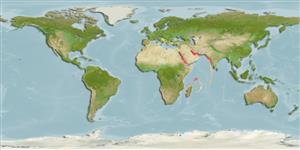Common names from other countries
Classification / Names / Names
俗名 | 同种异名 | Catalog of Fishes (gen., sp.) | ITIS | CoL | WoRMS
Environment: milieu / climate zone / depth range / distribution range
生态学
; 深度上下限 9 - 200 m (Ref. 128606), usually 20 - 40 m (Ref. 3497). ; 30°N - 7°N, 32°E - 88°E
Indian Ocean: from Red Sea north to Orissa India. Introduced in the Mediterranean.
Length at first maturity / 大小 / 重量 / 年龄
Maturity: Lm ? range ? - ? cm Max length : 21.6 cm TL 雄鱼/尚未辨别雌雄; (Ref. 365); common length : 15.0 cm TL 雄鱼/尚未辨别雌雄; (Ref. 365)
Length: common up to 15 cm (Ref. 363).
Even if it currently does not have a commercial importance in the Mediterranean (rare on the markets of Cyprus, Israel and Turkey), this species can have a potential importance for fishing. Common on the markets of Suez and lsmaïlia. Maximum depth from Ref. 122160.
Life cycle and mating behavior
成熟度 | 繁殖 | 产卵场 | 卵 | 孕卵数 | 仔鱼
Some members of the order Stomatopoda pair for life and some come together only to mate. Males produce sperm ducts rather than spermatophores; females can brood a maximum of 50,000 eggs. Life cycle: Eggs hatch to a planktonic zoea which lasts for 3 months.
主要参考文献
参考文献 | 合作者 | 合作者
Manning, R.B. 1995. (Ref. 3145)
世界自然保护联盟红皮书 (Ref. 130435: Version 2024-1)
Not Evaluated
Not Evaluated
对人类的威胁
人类利用
渔业: 商业性
| FishSource |
工具
网络资源
Estimates based on models
脆弱性
Low vulnerability (12 of 100).
